Reviewing the New Zealand Emissions Trading Scheme
Stuart Orme, New Zealand Tree Grower February 2016.
The government has begun its review of the ETS and has released a review document for consultation. The executive are putting together a comprehensive response on behalf of the NZFFA. A summary of this response we hope to publish in the next issue of Tree Grower.
This article has been written independently by Stuart Orme. It gives some background to the ETS, the review and recommends why you should respond.
In the late 1800s the government identified that if logging and land clearing continued at the rates predicted, New Zealand would run out of wood for domestic purposes by the 1960s. From this knowledge they formed what became the NZ Forest Service and put in place programmes which saw private central North Island forest planted, associated with company processing in Tokoroa and Kawarau. These initiatives alone accounted for the planting of over a million hectares of exotic forestry by the 1980s.
In the early 1990s, supported by positive government policy and an international market willing to pay good prices, New Zealand saw an immediate and sustained increase in new planting, funded this time by private landowners and investors as opposed to a corporate forest industry. These plantings diminished as woodlot profitability changed and land prices improved. However, a new resurgence in planting by the same type of investors was seen with the introduction of the Emissions Trading Scheme in 2008. Between 2009 and 2013 the perceived ability for forest owners to enjoy a cashflow from the sale of carbon credits was responsible for 45,000 to 50,000 hectares of new forest. As an aside this provided immediate eco benefits that regional councils had been unsuccessfully advocating for years in some regions.
The shift in Crown focus from emission reduction to least cost abatement coincided with the New Zealand Unit carbon price plummeting, along with the infamous Budget decision in 2014 confirming that all participants are equal but some participants are more equal than others. The result was an immediate halt to new plantings around New Zealand, strained relations between New Zealand’s third largest exporter and the Crown, and a return to nett deforestation.
The Review
The original ETS as implemented with Labour and National under Dr Nick Smith was well on the way to supporting our cherished Pure NZ brand. Introduction of the least cost abatement policy and the Crown’s refusal to implement their own requested recommendations regarding forestry or work positively with the industry has left the ETS crippled, forestry participants exposed, and New Zealand well on the way to having one of the biggest emission blow-outs in the developed world.
This ETS Review offers you the chance to have your say. The review document is structured well in that it provides easy-to-understand explanations of the issues, followed by direct questions for the reader to contemplate and respond to.
The review will focus on three main areas. The first area includes the transitional measures that were put in place in the initial stages of the ETS to moderate its initial effect. They are in fact still in place and –
- Allow non-forestry participants to surrender only one emission unit for every two tonnes of emissions
- Provide participants with the option to buy NZUs from the government for a fixed price of $25, limiting the potential costs faced by emitters
- Indefinitely delay the introduction of surrender obligations for the agriculture sector
- Indefinitely delay reductions in the level of free allocation of NZUs to protect the competitiveness of businesses involved in emissions-intensive and trade exposed activities.
The other two areas for the Review are –
- The evolution of the ETS design, takes into account the changing conditions in which it operates
- Operational and technical improvements.
The government has identifed two priorities –
- The move to full surrender obligations for emitters, removing the two-for-one transitional measure
- Managing the cost of such a move.
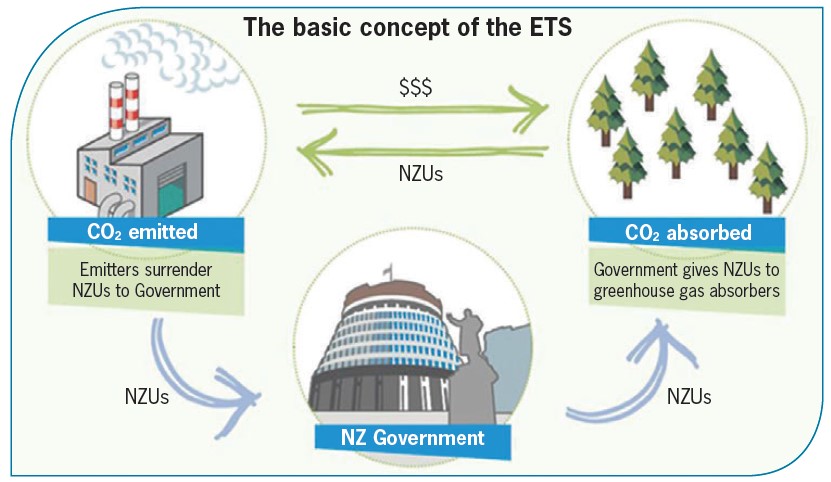
| The four key results the government would like to achieve | |
|---|---|
| Improve the performance of the ETS against its objectives | Currently 80 million unit emission well above original 1990 benchmark |
| Prepare for a more carbon-constrained future | Forestry can provide the required buffer to do this in an emission neutral way |
| Increase certainty about future policy settings | Definitely required for forestry to be able to participate |
| Manage banked emissions | These belong to individuals and entities and should not be managed by the Crown at all |
Surrendered units
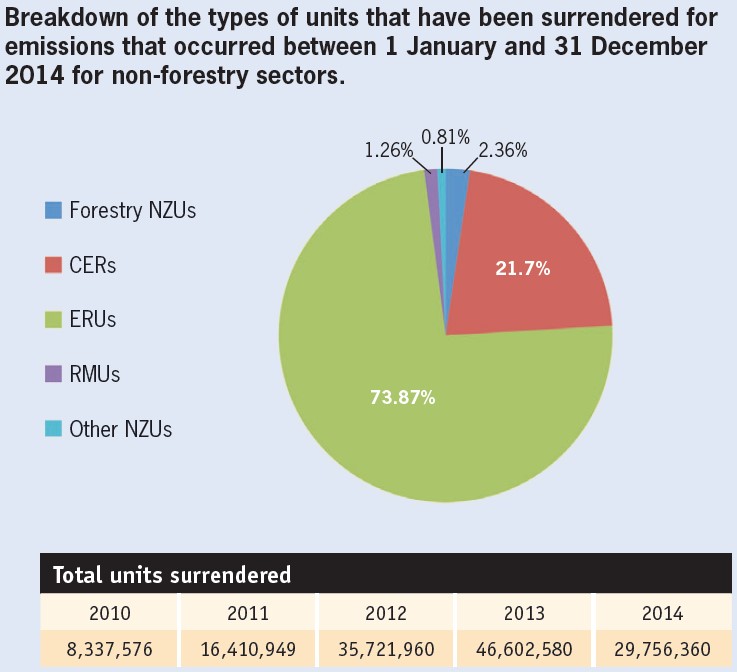
Up until the end of 2014, New Zealand emitters were allowed to surrender Kyoto units to account for their New Zealand based emissions. The diagram shows that by far the majority of those who had to surrender units did in fact surrender Kyoto units, and that the volume of NZUs surrendered was minimal. This was especially so, given the number of NZUs that the Crown gave to industry to surrender to avoid any trade exposed losses that those industries chose to keep and surrender the much cheaper Kyoto units in their place.
This, combined with the ability to surrender Kyoto units in full effectively drove the NZU price down to the point that those who had registered forest land into the ETS found themselves financially disadvantaged for doing so. This was compounded by the Budget decision of 2014 that effectively locked forestry participants in a no-win situation. Although new planting rates had reduced due to the declining NZU price, they abruptly stopped.
From the beginning of 2015 emissions obligations were still 50 per cent of actual due to the two-for-one amnesty must be accounted for with NZUs. These are due for surrender by the end of May 2016. The graph looks at the recent price rise of the NZ carbon unit now that they are back in demand.
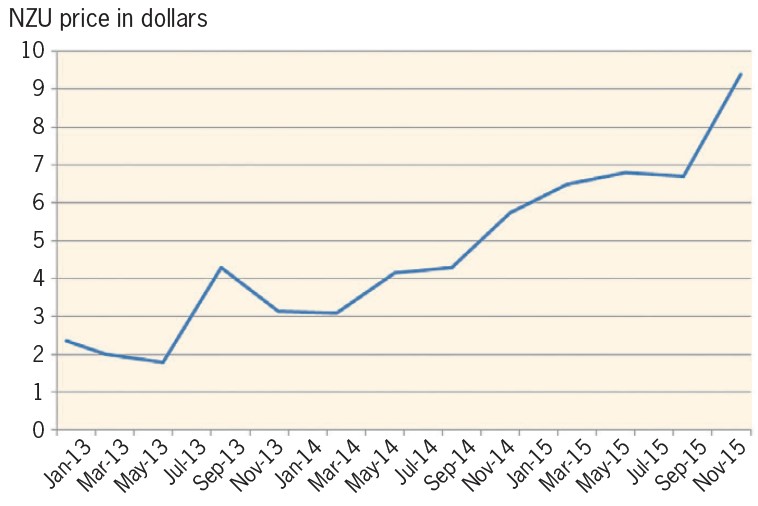
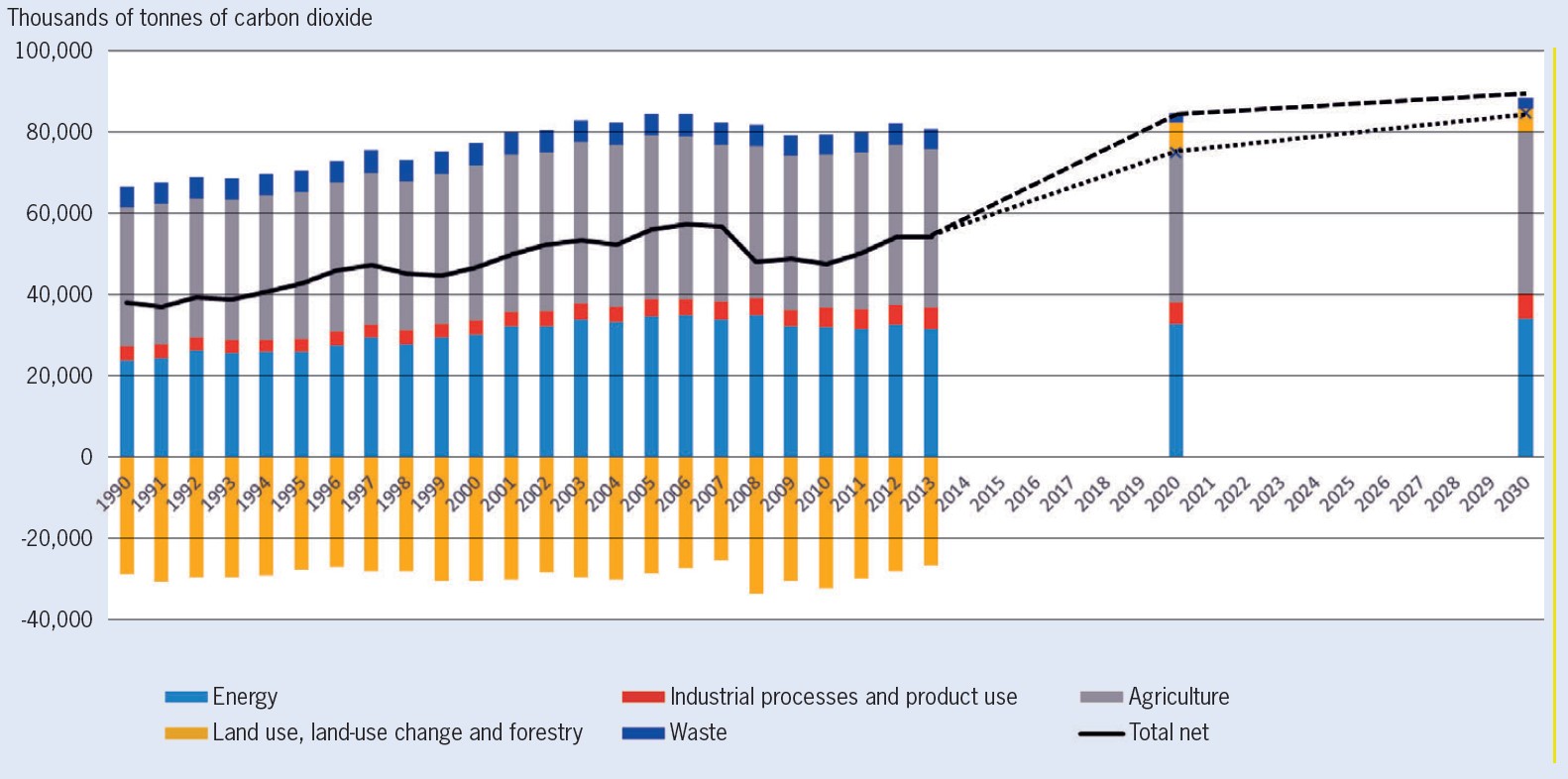
Emission levels
The graph on the previous page shows the historic and predicted emission levels from New Zealand. In round numbers New Zealand emitted 60,000,000 tonnes of carbon dioxide equivalents in 1990 and it is this benchmark that the country signed to remaining at or reducing.
The graph also shows that our actual emissions have increased to around 80,000,000 tonnes of carbon dioxide equivalent over that period, but due to post-1989 forest sequestration this has reduced to well below the 60,000,000 tonne target for international accounting purposes. With the approaching harvest of our post-1989 forests and remarkable lack of new planting this buffer is about to disappear in the very short term future.
Positive forestry ETS involvement
New Zealand has an estimated 2,000,000 more hectares which would be deemed more productive if in other vegetation as opposed to current pastoral and or other uses. Under the right conditions planting the right species on the right land could and would start again. Forestry has the potential to be the short term solution to emission projections and it wants to be part of the solution.
For the ETS to work for forestry all the passion and policy in the world will not underpin the ability to make good investment decisions. Unless there is profit it will not happen. Whether it be exotic radiata pine, another exotic species or the emerging manuka plantings and indigenous reversion, there needs to be a recognition of the large eco benefits of long-term afforestation to the landscape and environment and that not all carbon is lost when trees are harvested.
Permanently retaining credits
The initial perceived advantage of the ETS was that it offered forest growers the opportunity to enjoy a cashflow early in the forest cycle from the potential sale of carbon credits. At the time of its promotion there was a perception that a percentage of the carbon created and sold would not need to be handed back the Crown as long as the forest was replanted. This is partly true of plantings in the late 2000s onwards. However, a better understanding of the fine print shows that when the land eventually changes hands it is reasonable to expect an obligation will be triggered to surrender all that has been allocated because a new owner is unlikely to want to take on the ‘transferred obligation’.
If New Zealand adopted changes to the ETS that allow for a percentage of vegetation credits to be permanently retained by the grower as long as the land is replanted or stays in vegetation, then landowners and investors would reconsider their options that could lead to reigniting new planting and prompt reversion. Added to this is the justifiable ability to increase this amount by a percentage used in some form of long term wood products.
Another factor of importance to forest growers is knowing that the credits issued have an infinite life. They should not become void at some point in time in the future before the trees are harvested and the required percentage of credits need to be surrendered. A 50-year rotation of Douglas-fir is not unheard of.
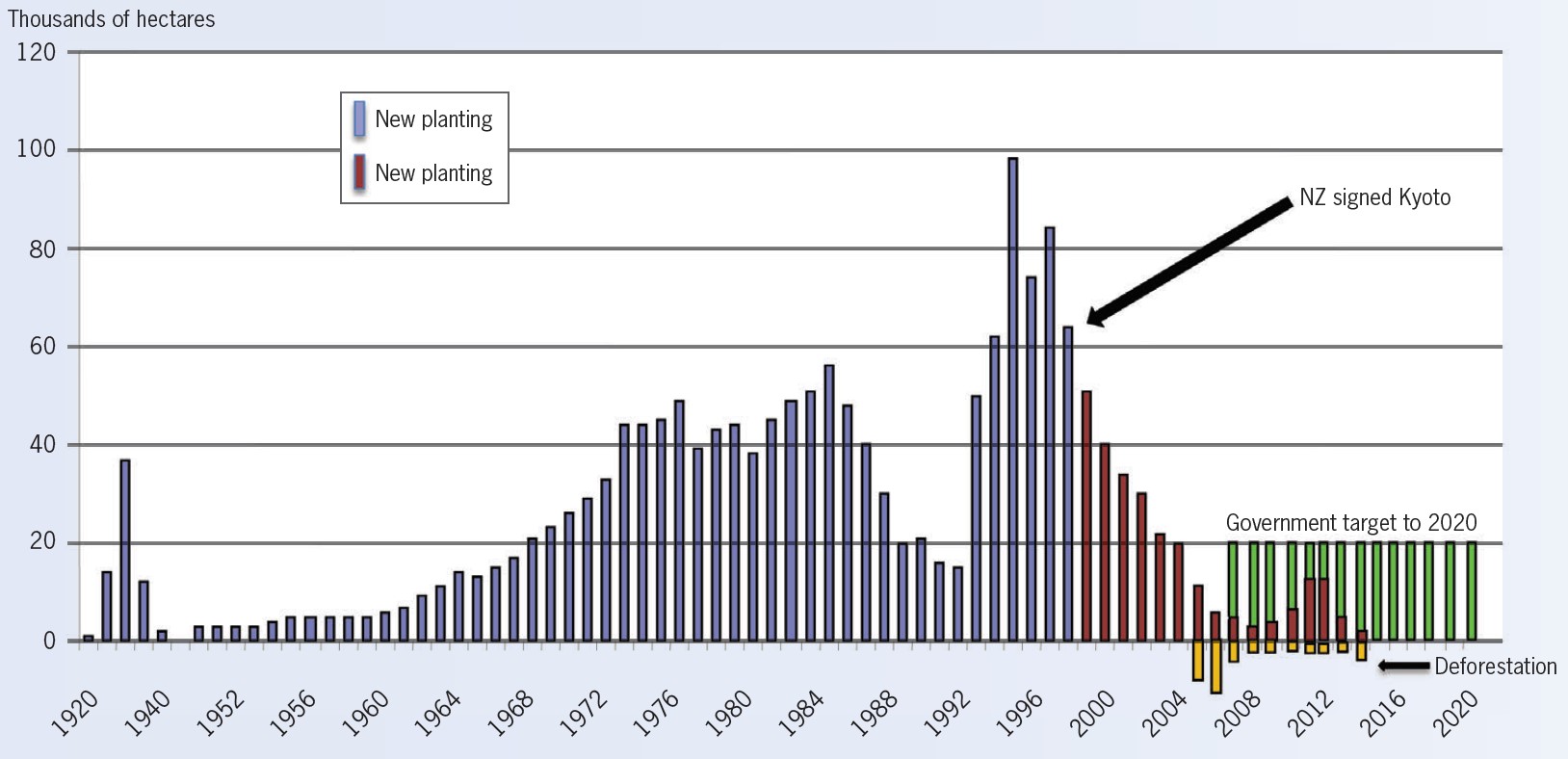
Summary and opportunity
The Crown effectively drove the NZU price down by not restricting the surrender of off-shore units. Its move to restrict forest participants using Kyoto units clearly showed it understood the implications but still they chose to favour industry over scheme integrity. This single move alone has contributed to forest and landowner participants leaving or becoming neutral on their ETS involvement.
Equally, forestry wants and can still be the solution that buys time to meet emission obligations and targets, but foresters wish to be recompensed for what they do, not punished and controlled to achieve government policy. In the late 1800s the government helped establish what today is the third largest export earning industry
for our nation. In 2014, focused on next year’s budget and a couple of opinion polls, they effectively crippled investment interest in it. The graph shows new planting rates since 1920.
With an expanding manuka industry requiring new plantings alongside a proven forest industry and existing infrastructure and up to two million hectares of land that would benefit both, all that is missing is the business confidence to invest in the new plantings and associated management.
This ETS review is a watershed opportunity for the promotion of best land use, right species in the right place and a greener New Zealand. We encourage you to respond to the review and support the Crown to make informed decisions in this ETS review. We will not get another chance to get it right. More information regarding the submission process and a copy of the Review Discussion Document can be found at www.mfe.govt.nz
Stuart Orme of Woodnet is a Registered Forestry Consultant based in Masterton.


 Farm Forestry New Zealand
Farm Forestry New Zealand